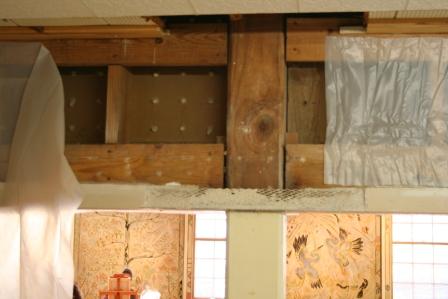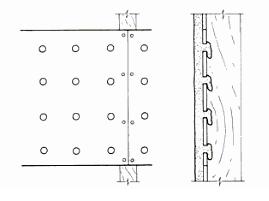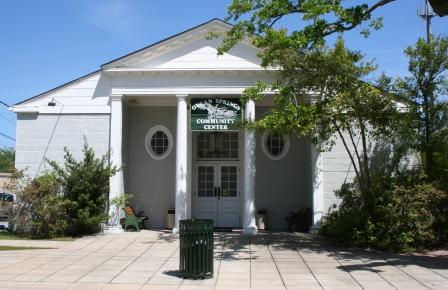Have you ever seen a material attached to a wall that looked like drywall but maybe had some holes in it and possibly some plaster stuck to one side? It’s possible you never have. The material is called Rock Lath and much like our past MissPres Architectural Word of the Week “Grounds,” if it does it job correctly and without interference it will never be seen.
While similar to modern Drywall (Sheetrock) as a gypsum material, rock lath was treated chemically so it would be capable of accepting a wet veneer of plaster. (This might also speak to why even though submerged during Katrina for several hours the rock lath did not mold the same way Drywall does.) The most obvious difference between today’s Drywall and Rock Lath is that in Rock Lath a 5/8″ hole is cut to allow the brown coat of plaster to spill through and create a key. These keys harden to hold the plaster veneer to the Rock Lath. The Rock Lath itself comes in sheets 16″ x 48″ and 1/2′ thick. These sheets were applied to the wall in the same fashion as Drywall. When all the Rock Lath is installed on the wall a brown coat (or undercoat) of plaster approximately 1/2′ thick is applied to the Rock Lath. The finish coat of plaster is applied after the brown coat has dried. The time saver with this process is that a third coat, the scratch coat–normally required in a normal lath and plaster wall–and its drying time are eliminated from the process. Unfortunately good keys were rarely formed in Rock Lath and the chemical bond between the board and plaster must keep the wall section together.
In the 1942 portion of the Old Pascagoula High School building to save time on construction and possibly due to rationing, this new material was used for the walls rather than the plaster that was used in the ’38-’39 section of the building. Rock Lath at this point almost exclusive used for residential construction was coming into use in non-residential construction, and by the 1950’s would be used almost as frequently as expanded metal lath.
Another building in Jackson County that utilizes Rock-Lath is the Ocean Springs Community Center. This building might also contain the world’s most valuable rock lath wall. On the interior of this c. 1950 concrete block and asbestos clad community center is a mural painted by Ocean Spring’s best known artist, Walter “Bob” Anderson. In perhaps the best investment offer ever Mr. Anderson offered to paint a mural on the walls of the community center for $1. Today the mural is valued in the double-digit millions of dollars. While most of the mural is painted on plaster walls over concrete-block, one small section over an alcove is painted on Rock Lath. The wood frame work over the alcove has settled differently than the rest of the block building, causing some cracking in the mural. The city has just finished a Save America’s Treasures grant from the National Park Service to stabilize the mural, and the space looks great.

Ocean Springs Community Center: Above the alcove the mural on rock lath has been temporarily stabilized. Photo from MDAH HRI Database.
I hope you’ve enjoyed our little lesson on rock lath. It just goes to show, you never know what’s lurking in our walls.
Categories: Architectural Research, Gulf Coast, Historic Preservation, Ocean Springs, Pascagoula, Renovation Projects, Schools





I was in a house in Waveland after Katrina that had rock lath. It was north of the tracks but had still taken on quite a bit of water. There was black mold on the wall but only the lower four feet of the wall, with a distinct line going all the way around. I said, “oh, that’s where the water line is,” but the homeowner said, “no, there’s rock lath on the lower wall and normal wood lath above, and the mold is where the rock lath is.” That was the first time I had ever heard of rock lath. I assume they had to rip it all out since it was so badly molded.
LikeLike
The down side of rock lath and drywall is that it is made from Gypsum which is water soluble and will dissolve when exposed to water for too long. It can be chemically treated (like to accept a layer of wet plaster) to prevent solubility but these treatments only act as a resistance and not a “proofing”.
Gypsum plaster does not have the natural resistance to mold that lime plaster does. Lime plaster by itself is too toxic an environment for most molds to live in.
LikeLike
I have a home in California that has rock lath. Where can I find rock lath materials ?
LikeLike
Wow! 1/2 foot thick rock lath and 1/2 foot thick plaster! That’s amazing!
LikeLike